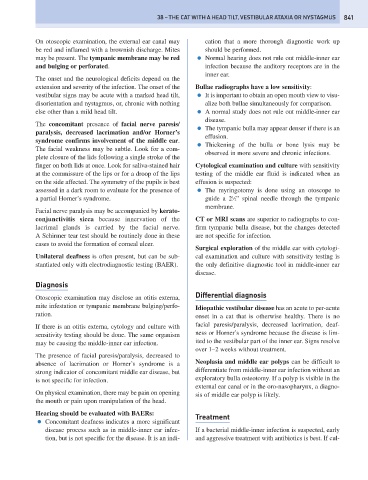Page 849 - Problem-Based Feline Medicine
P. 849
38 – THE CAT WITH A HEAD TILT, VESTIBULAR ATAXIA OR NYSTAGMUS 841
On otoscopic examination, the external ear canal may cation that a more thorough diagnostic work up
be red and inflamed with a brownish discharge. Mites should be performed.
may be present. The tympanic membrane may be red ● Normal hearing does not rule out middle-inner ear
and bulging or perforated. infection because the auditory receptors are in the
inner ear.
The onset and the neurological deficits depend on the
extension and severity of the infection. The onset of the Bullae radiographs have a low sensitivity:
vestibular signs may be acute with a marked head tilt, ● It is important to obtain an open mouth view to visu-
disorientation and nystagmus, or, chronic with nothing alize both bullae simultaneously for comparison.
else other than a mild head tilt. ● A normal study does not rule out middle-inner ear
disease.
The concomitant presence of facial nerve paresis/
● The tympanic bulla may appear denser if there is an
paralysis, decreased lacrimation and/or Horner’s
effusion.
syndrome confirms involvement of the middle ear.
● Thickening of the bulla or bone lysis may be
The facial weakness may be subtle. Look for a com-
observed in more severe and chronic infections.
plete closure of the lids following a single stroke of the
finger on both lids at once. Look for saliva-stained hair Cytological examination and culture with sensitivity
at the commissure of the lips or for a droop of the lips testing of the middle ear fluid is indicated when an
on the side affected. The symmetry of the pupils is best effusion is suspected:
assessed in a dark room to evaluate for the presence of ● The myringotomy is done using an otoscope to
1
a partial Horner’s syndrome. guide a 2 ⁄2” spinal needle through the tympanic
membrane.
Facial nerve paralysis may be accompanied by kerato-
conjunctivitis sicca because innervation of the CT or MRI scans are superior to radiographs to con-
lacrimal glands is carried by the facial nerve. firm tympanic bulla disease, but the changes detected
A Schirmer tear test should be routinely done in these are not specific for infection.
cases to avoid the formation of corneal ulcer.
Surgical exploration of the middle ear with cytologi-
Unilateral deafness is often present, but can be sub- cal examination and culture with sensitivity testing is
stantiated only with electrodiagnostic testing (BAER). the only definitive diagnostic tool in middle-inner ear
disease.
Diagnosis
Differential diagnosis
Otoscopic examination may disclose an otitis externa,
mite infestation or tympanic membrane bulging/perfo- Idiopathic vestibular disease has an acute to per-acute
ration. onset in a cat that is otherwise healthy. There is no
If there is an otitis externa, cytology and culture with facial paresis/paralysis, decreased lacrimation, deaf-
sensitivity testing should be done. The same organism ness or Horner’s syndrome because the disease is lim-
may be causing the middle-inner ear infection. ited to the vestibular part of the inner ear. Signs resolve
over 1–2 weeks without treatment.
The presence of facial paresis/paralysis, decreased to
absence of lacrimation or Horner’s syndrome is a Neoplasia and middle ear polyps can be difficult to
strong indicator of concomitant middle ear disease, but differentiate from middle-inner ear infection without an
is not specific for infection. exploratory bulla osteotomy. If a polyp is visible in the
external ear canal or in the oro-nasopharynx, a diagno-
On physical examination, there may be pain on opening sis of middle ear polyp is likely.
the mouth or pain upon manipulation of the head.
Hearing should be evaluated with BAERs:
Treatment
● Concomitant deafness indicates a more significant
disease process such as in middle-inner ear infec- If a bacterial middle-inner infection is suspected, early
tion, but is not specific for the disease. It is an indi- and aggressive treatment with antibiotics is best. If cul-

